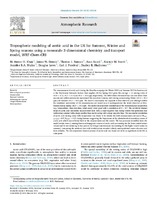| dc.contributor.author | Shallcross, D.E | |
| dc.contributor.author | Khan, M.A.H | |
| dc.contributor.author | Dennis, J.W | |
| dc.date.accessioned | 2021-04-15T09:02:25Z | |
| dc.date.available | 2021-04-15T09:02:25Z | |
| dc.date.issued | 2021 | |
| dc.identifier.citation | Shallcross, D.E. (2021). Tropospheric modeling of acetic acid in the UK for summer, winter and spring seasons using a mesoscale 3-dimensional chemistry and transport model, WRF-Chem-CR. Atmospheric Research, 254,105506 | en_US |
| dc.identifier.issn | 0169-8095 | |
| dc.identifier.uri | 10.1016/j.atmosres.2021.105506 | |
| dc.identifier.uri | http://hdl.handle.net/10566/6039 | |
| dc.description.abstract | The measurement of acetic acid during the ClearfLo campaign for Winter 2012 and Summer 2012 in London and at the Weybourne Research Station (East Anglia), UK for Spring 2013 gives the average ± 1σ mixing ratios of 45.9 ± 31.5, 25.7 ± 14.3 and 55.1 ± 32.0 ppt, respectively. The WRF-Chem-CRI model was run over these three seasons and within uncertainty reproduced the data from London, with mixing ratios during Winter (32.3 ± 25.3 ppt) and Summer (55.1 ± 22.6 ppt). The model's seasonality was opposite to that observed and although within the combined uncertainty of the measurement and model data it underpredicted the levels observed at Weybourne during Spring (28.9 ± 19.3 ppt). The model-measurement correlations of the meteorological parameters (e.g. temperature, wind direction, wind speed) were good with a correlation of R > 0.7. The predicted diurnal trend of acetic acid resembled measurement data with a small negative bias during winter but performed less well during summer with a large positive bias and in spring with a large negative bias. The reasonable correlation of acetic acid mixing ratios with temperature was found to be similar for both measurement and model (Rmeasurement = 0.5, Rmodel = 0.6) during Summer suggesting the importance of the photochemical secondary source of acetic acid which was reflected both in the measurement and the model. The key processes identified from the model results were a) missing direct anthropogenic sources of acetic acid (accounting for the lower model winter values) and b) not including its loss process by Criegee intermediates (accounting for the higher model values in summer). Comparing the weekend data with weekday data revealed a likely underpredicted source of acetic acid from vehicles. The wet deposition removal process of acetic acid was found not to be as significant in the UK as anticipated. | en_US |
| dc.language.iso | en | en_US |
| dc.publisher | Elsevier | en_US |
| dc.subject | Anthropogenic sources | en_US |
| dc.subject | Criegee intermediates | en_US |
| dc.subject | Diurnal trend | en_US |
| dc.subject | Meteorological parameters | en_US |
| dc.subject | Seasonal variation | en_US |
| dc.subject | Wet deposition | en_US |
| dc.title | Tropospheric modeling of acetic acid in the UK for summer, winter and spring seasons using a mesoscale 3-dimensional chemistry and transport model, WRF-Chem-CRI | en_US |
| dc.type | Article | en_US |

